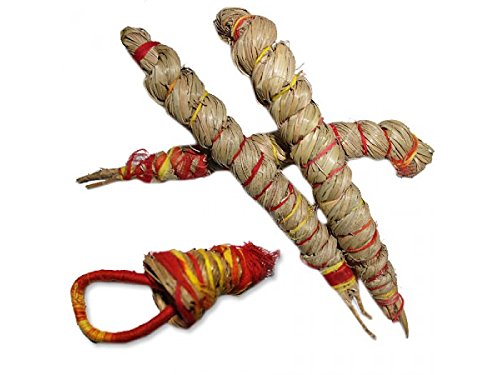Sunil Kumar
Shipping Price - Flat 10A$ Charges or Get Free Shipping on order above 80A$ with minimum 3 Qty.
The set comprises of: 1.Two ring made of kusha grass is wore on the ring finger of the person performing the ritualistic ceremonies. These rings are known as pavitra (sacred) rings for the puja or Pavitri. The head priest or the the Yajmaan (person for whom puja is done) wears this darbha ring representing the sacred knot or hair-curl (Skt. shrivatsa) of Vishnu. 2. Set of 2 bundles of sacred Kusha grass with roots for purifying during the puja or ritual ceremonies. Kusha grass is known to be the purifying object. The sanctity of dharba or kushais as old as the Indian gods. Puranas tell how Vishnu assumed the form of the Cosmic Tortoise (Skt.kurma) whose shell served to support Mandara the mountain that served as a dasher in the churning of the sea of milk. As the mountain rotatedseveral hairs were rubbed from the tortoise's back. With time they washed ashore and became Kusha. Later when the amrita (nectar) was obtained and distributed among the godssome drops fell on the grass which further sanctified it imbuing it with healing properties. Thereforein the tradition hair-cutting of Vaishnava toddlers the hair is touched with kusha before it is cut. It was used as a ritual seat as far back as the Vedas and the Bhagavad Gita (ch.6)stipulates thatcovered with a skin and a clothit is the appropriate seat for meditation. Science says about Darbha: In recent medical research Darbha or Kusha grass has been observed to block X-Ray radiation. It is scientifically known as Panic grass and of genus borage species. It can grow up to 2 feet and it appears pointed at the top. Significance of Darbha: The significance of Darbha grass is also found in Buddhist culture. It is believed that Sakyamuni Buddha sat on a Darbha mat to meditate and got enlightened under the Bodhi tree. The capital city of Malla kingdom of Buddhist is named Kushinagara just to honor Kusha grass. It was in this city Lord Buddha was cremated.
Country of Origin:
India
Brand:
Daily Need Store
Razeen
Deepak Parmar
RUCHI











